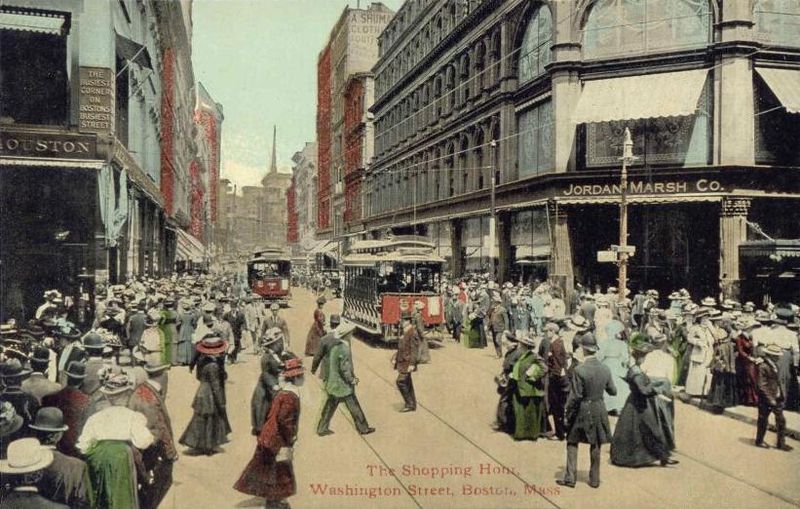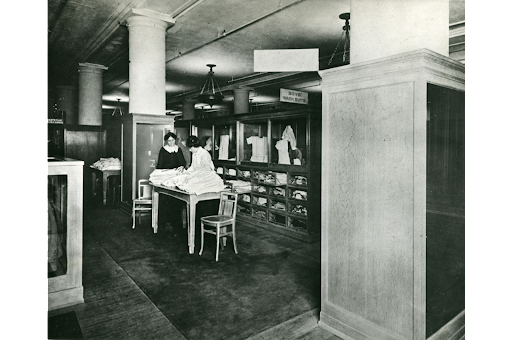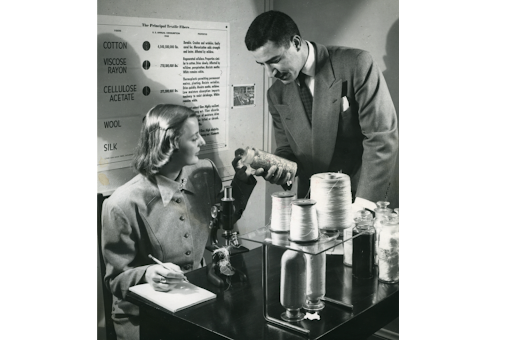Boston’s Department Store Workers: Wage-Earning Women from the Women’s Voter Registers
Among the 50,000 women who registered to vote in Boston in 1920, a large number worked in various occupations in the city’s department stores.
by Anna Boyles
Women in the United States entered the workforce in increasing numbers throughout the 1900s. By 1920, however, only about twenty percent of women in the U.S. were employed outside of the home. Retail businesses hired female workers, and the department stores in downtown Boston employed large numbers of women to operate these huge establishments. Journalist and suffragist Rheta Childe Dorr observed in 1910 just how essential women workers were to the operation of American department stores:
“Buying and selling, serving and being served—women. On every floor, in every aisle, at every counter, women . . . . Capably busy at the switch boards, women. Down in the basement buying and selling bargains in marked-down summer frocks, women. Up under the roof, posting ledgers, auditing accounts, attending to all the complex bookkeeping of a great metropolitan department store, women. Behind most of the counters on all the floors between, women. At every cashier's desk, at the wrappers' desks, running back and forth with parcels and change, short-skirted women . . . . Simply a moving, seeking, hurrying mass of femininity, in the midst of which the occasional man shopper, man clerk, and man supervisor, looks lost and out of place.”
After the turn of the twentieth century, department stores came to dominate the retail centers of cities like Boston. The overwhelming majority of those working in these businesses were women. Transcribers with the Mary Eliza Project discovered a large number of women employed in Boston department stores listed in the General Register of Women Voters of 1920. These women served as counter girls, sales ladies, dressmakers, clerks, and elevator operators in a number of department stores downtown such as Jordan Marsh, Filene’s, R.H. Stearns, and Gilchrist’s.
According to Susan Porter Benson, male managers and supervisors worried about the capability and efficiency of the female salesforce. They previously believed that businesses simply needed to staff store counters with attractive and polite women, who would act as cogs in the machine of retail. Managers learned by the 1910s that retail workers required select knowledge and interpersonal skills to most effectively sell merchandise. The relatively low pay, long hours, and difficult working conditions offered by department stores discouraged middle-class and educated women from seeking employment in positions on the shop floor. Department stores still appeared to be a promising opportunity for working-class women, but Black women were shut out from most available positions. Mobility within the business attracted many young women, but some reformers questioned just how far it was possible to rise through the ranks without proper education.
Lucinda W. Prince of Boston established a retail training school in the city in 1905. During her time as a social worker and an executive with the Women’s Education and Industrial Union, Prince discovered the apathy that department store workers felt toward their low-paying jobs. She believed that with the right training, these women could become happier and more successful retail workers. A number of stores partnered with Prince’s School of Salesmanship to offer students positions within their stores. This model of practical and classroom experience was successful, and Simmons College (now Simmons University) began offering Prince’s program to their students by 1920.
Those who graduated from this program entered the job market with more expertise and more power to supervise and make decisions in the department stores and retail establishments of Boston. In the fall of 1920, many women department store workers of all levels registered to vote in Boston. The voter registers documented this new and changing profession for women. The Mary Eliza Project datasets reveal the variety of occupations held by Boston women at this time.
Read more:
- What Eight Million Women Want by Rheta Childe Dorr
- Women and the City: Gender, Space, and Power in Boston, 1870-1920 by Sarah Deutsch
- “The Cinderella of Occupations: Managing the Work of Department Store Saleswomen, 1900-1940” in The Business History Review by Susan Porter Benson
- Education for Work: The Historical Evolution of Vocational and Distributive Education in America by Arthur F. McClure, James Riley Chrisman, and Perry Mock
Anna Boyles is a fourth year undergraduate history student at Simmons University.






